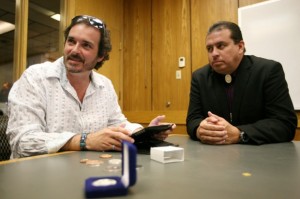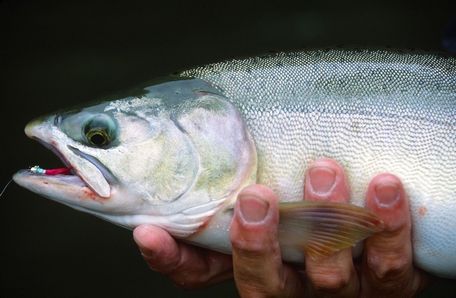Sharon Salyer, The Herald
EVERETT — Laura Montejano is convinced that electronic cigarettes helped wean her off her long-standing pack-and-a-half-a-day smoking habit.
Even while standing in the middle of Tobacco Joe’s, an Everett Mall Way smoke shop, Montejano proudly proclaimed that it had been 104 days since her last cigarette.
Montejano, 37, from Woodinville, pointed to her phone ap that calculates exactly what cessation of $7-a-pack cigarettes has meant in her life — a savings of at least $728.
And with each cigarette typically taking about seven minutes to smoke, she’s freed up the equivalent of more than eight days of time.
“My kids are thrilled; I’m thrilled,” she said.
She credited her personal vaporizer, also known as an e-cigarette, with allowing her to quit. “Having this was such a huge thing,” she said.
The tubular, battery-driven machine has a small tank of nicotine-laced liquid. When someone takes a draw, it creates a puffy white cloud.
It looks similar enough to smoking that questions are being raised both locally and in other parts of Washington: Is this non-tobacco activity banned under the state’s tough indoor smoking ban?
Both Pierce and King counties treat e-cigarettes like regular cigarettes, passing ordinances specifically banning their use indoors in public places.
“Prior to this, we were getting complaints from bars and restaurants having clients using these products in their business,” said Scott Neal, a tobacco prevention manager for Public Health — Seattle and King County.
If a customer saw someone across the room exhaling a plume from their e-cigarette, they might mistakenly believe that regular smoking was allowed, he said. “It became a problem for bar owners,” Neal said.
Dr. Gary Goldbaum, health officer for the Snohomish Health District, said the agency interprets current bans on smoking in public places to include e-cigarettes.
“We’re advising restaurant and bar owners that they should not be permitting use of these devises in their premises,” he said.
Goldbaum said he will likely recommend that the health district’s board consider taking action specifically banning indoor e-cigarette use in public places.
“We believe it would be helpful to have a local ordinance that clearly defines that so there’s no question,” he said.
To date, the state hasn’t taken any action to regulate e-cigarettes except to prevent their sale to anyone under the age of 18, said Tim Church, a state Department of Health spokesman.
“Right now, local jurisdictions seem to be taking this on and coming up with regulations and ordinance that work for their communities,” Church said.
Questions have been raised over whether e-cigarettes are perceived as a safe alternative to smoking.
“There’s a lot of unknowns about these electronic cigarettes,” Goldbaum said. “We honestly don’t know if they’re harmful and if so, how harmful they may be.”
The few studies that have been done on the products show that some carcinogens or toxins can be detected at very low levels in the vapors, he said.
That raises questions about long-term health effects for the user, or vapor, and second-hand exposure, Goldbaum said.
Yet even Goldbaum acknowledges that e-cigarettes almost certainly pose less health risk than tobacco-filled cigarettes
Annie Peterson, who works as a healthy communities specialist for the Snohomish Health District, said she has concerns that if e-cigarettes are promoted as harmless, “that’s a big draw for youth.”
Peterson said she’s also questions whether some of the candy-like flavoring and labeling of the nicotine liquids used in e-cigarettes, with names such as bubblegum, could also be subtle attempts at marketing to teens.
Kids may not realize that nicotine addiction can occur with e-cigarettes, too, she said.
Nevertheless, sales of e-cigarettes is growing rapidly, with the products available online and at area retailers.
Jeremy Wilson, 33, a Naval officer stationed in Hawaii, and his wife, Elizabeth Wilson, 32, who served in the naval reserves, have announced plans to open an e-cigarette business in the Everett Mall next month.
Joe Baba, owner of Tobacco Joe’s, said the store first began offering e-cigarettes in January, initially just with disposable e-cigarettes and later expanding to reusable vapors.
“I found myself in the middle of a landslide of demand, being one of the only retailers in the Everett area,” he said.
The store has a “vapor bar,” where customers can have free samples of more than 20 flavors of “juice” as nicotine containers are known.
Starter kits can be purchased for $34.99. The most expensive vapors, with longer battery life, sell for $150. The vapors can be adjusted so that consumers “can choose their level of nicotine down to zero,” Baba said.
Baba said a number of customers have said they’ve been able to convert from cigarette smoking to vaping. “It’s a real joy to see,” he said.
Baba said the switch from traditional to e-cigarettes reminds him or the evolution of technology, “like cell phones versus land lines.
“For the first time in 200 to 300 years,” he said, “cigarettes finally have some real competition.”














